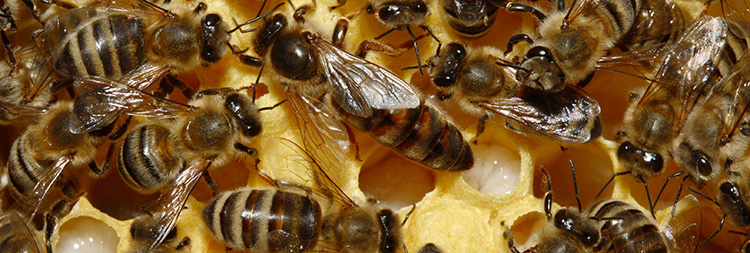Transgenic Honeybees To Help Research

(Inside Science) -- Bees are known to dance, wiggle and use sophisticated techniques to communicate information to their fellow pollinators. Now, researchers may be able to improve their understanding of the genetic underpinnings of bee behavior by inserting foreign genetic material into bees.
Christina Schulte and her colleagues at Heinrich Heine University Duesseldorf in Germany developed a protocol to create transgenic bees for the first time. Genetic manipulations in the name of science have existed for decades for the science-friendly fruit fly and even mice, but bees have resisted such intrusions.
To insert the material, researchers must pull bee embryos out of their hive and inject new genetic material into them. The nurse bees tend to sniff out babies that have been altered -- with dire consequences.
"The nurse bees that take care of the eggs need to be able to recognize the eggs as being okay, or they won't take care of them," said David O'Brochta, an entomologist at the University of Maryland, in College Park who was not associated with the current work. The eggs contain queens who then hatch and mate to produce transgenic drones -- male bees whose only job is to impregnate a queen.
Schulte was able to overcome this challenge and create genetically-modified queens who made transgenic clones, by injecting them with foreign DNA that made some cells glow. The research was published in the Proceedings of the National Academy of Sciences. In two experiments on 25 queens that hatched from the injected eggs, six produced progeny with the genes that marked them as transgenic.
She stressed that these bees will be used for research, and the study did not create a colony of transgenic bees. The bees were kept in an outdoor tent and tended to day and night. But she doesn't worry about the transgenic drones escaping -- they live in a special area with doors that allow the worker bees to come and go, but prevent the larger drones from exiting. The team did run into a particular bee problem, though: on an unusually cold day in the summer, the worker bees killed the queen.
But making bees with foreign DNA will let scientists peer into the neurobiology behind bees' particular social behavior. Bees are a fantastic model organism to study animal behavior, said Schulte. Her lab plans to study how sex-linked genes have an impact on behavior. If the scientists knock out a gene linked to male mating behavior or express it in females, they could see how the bees change their behavior -- the females could start behaving like males, for example.
The research might help identify factors in the health of bees as well.
Practical advances could also come from transgenic bees. "How are they so susceptible to verroa mites?" asked O’Brochta, "or what's their detoxification system like? Are they really super-susceptible to environmental cues that might be behind colony collapse disorder? Now they can test the genes involved and make a connection between the phenotype and genotype."
To improve bees' ability to overcome hazards like mites and parasites, most research is tuned into breeding programs that are similar to those used in farm animals. Thomas Rinderer, a research leader and research geneticist with the U.S. Department of Agriculture's Agricultural Research Service in Beltsville, Maryland, said the new research is a nice contribution to the overall field. Rinderer and his colleagues use a blend of classic genetic selection and molecular biology to breed bees that are resistant to viruses and parasites.
Working with bees brings unique issues to breeding efforts as well, said Rinderer.
"With cattle, if you have a bull that’s superior, not only does he live a long time, but you can store [frozen] semen … and bring it out to use it -- you only need one viable sperm to fertilize an egg."
For bees, only one sperm bank exists, and a lot of genetic material is required to carry on the bee line. Each queen lays 1,000 eggs per day, and stores up to 6 million sperm for use up to five years later -- doling out a few swimmers per egg. Many of the eggs are not fertilized, so they develop into drones instead of worker bees.
"Bees have their own benefits and some are marvelous, but there's an added degree of difficulty not found with other animal breeding," said Rinderer.
